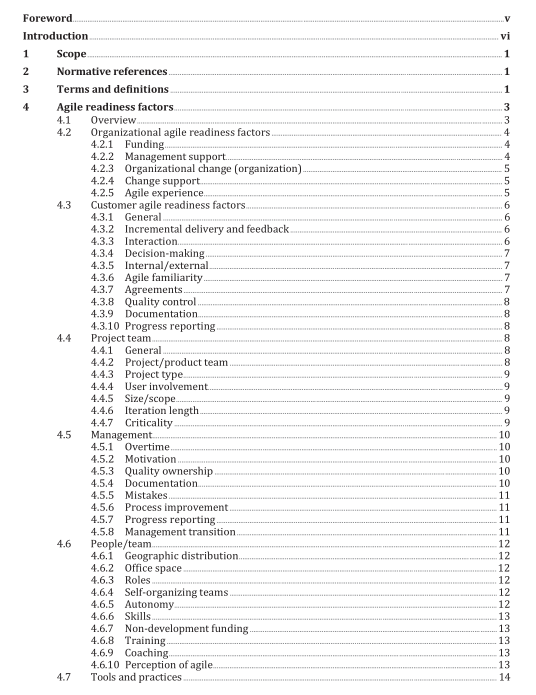ISO IEC TR 24587 pdf – Software and systems engineering — Agile development — Agile adoption considerations

ISO IEC TR 24587 pdf – Software and systems engineering — Agile development — Agile adoption considerations
In the following subclauses, each of the logical areas is considered in turn by identifying the individual factors relevant to the area and providing a description of how the factor can be used to assess the agile readiness of an organization or project. A quick reference guide to the factors is provided in Annex A . If an organization believes that they have most of the factors satisfactorily covered, then the organization can consider themselves ready to move to an agile development approach.
If there are several factors where it is clear the organization is lacking, then the organization can first decide to address these factors before they adopt their chosen agile methodology. For most of the agile readiness factors, it is not a simple case of satisfying them or not. There can be degrees of coverage to consider for a given factor and each organization will need to make a subjective judgement about each factor and how important it is to them. For instance, having employees that are experienced in using agile methodologies is a commonly used agile readiness factor. An organization attempting to transition to agile without any people experienced in agile is far less likely to succeed than one with many people that are experienced in agile. However, when considering this factor, an organization will be faced with making a subjective determination of the level of agile experience within their organization (both current level and the minimum level needed to mitigate the risk to transition). This can be based on how many people have agile experience, in what roles and perhaps the length of that experience, among other subjective considerations.
It is extremely rare for any organization to fully satisfy all of the listed agile readiness factors, and it is not expected that an organization would wait until every factor is fully satisfied before making the move to agile. In practice, satisfying only a few of these factors will benefit the user in most situations. With each factor there is a corresponding risk to making the agile transition and this risk will vary based on the context of the organization. Each organization will balance the risks associated with not fully satisfying a given set of readiness factors against the benefits expected to be achieved by moving to using an agile approach. Organizations can also consider the option of customising the agile practices suggested by the agile readiness factors to better fit their individual situations. Many of the factors not only apply to determining agile readiness, but they can also be used for determining a measure of agile maturity. An organization can have already adopted an agile approach to their development and can then use the factors to help them decide on areas where they can improve, even several years after having transitioned to using an agile approach.
In this case, the organization can use their experience of using an agile approach to help decide which outstanding factors are most likely to provide them with the most benefit at the least cost. NOTE This introduction has focused on an organization’s agile readiness, but most of the same factors also apply when determining the agile readiness of a department, single project or team within an organization. Where a factor is specific to assessing readiness for one or the other, it is highlighted.
4.2 Organizational agile readiness factors
4.2.1 Funding The transition to using an agile development approach typically requires significant funding, such as for training, tooling, resourcing and to support process transition. The move to agile is considered as a significant change management activity, and perhaps as a project in itself, and, as with any project, it needs to be resourced. Any associated transition plan will include estimates for necessary funding.
4.2.2 Management support The transition to using an agile development approach requires management support . Management support at all levels needs to be visible to all concerned. If it is an organizational transition, then the support will start at board and executive management level but will also include all levels of management throughout the organizational structure.









